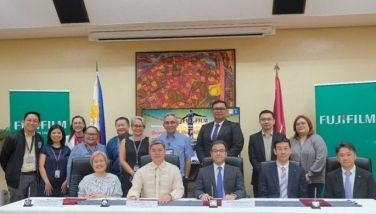450 years of love

A few blocks away from the Gates of Hell as interpreted by novelist Dan Brown, there is a UNESCO Human Heritage Site.
As it turns 450 this year, the San Agustin Convent and Museum in Manila’s Walled City is showing its age – in the wonderful way that good wine does.
San Agustin is a repository of Augustinian wealth – material, intellectual, artistic and spiritual. The rich heritage is reflected in the opulence of the church interiors.
As a child I was awed by the ornate carvings, the fascinating trompe-l’oeil interior painting, the baroque pulpit with a golden pineapple motif of the church. Within the thick walls the sounds of the city were muffled, and the intonations of the priests – who at the time still celebrated mass in Latin – bounced around in hushed tones, like disembodied voices.
Dressed in my Sunday best and wearing a veil (yes, women and girls did at the time), I thought the cavernous church interior, with the angelic choir and organ music, was a piece of heaven – definitely no place for childish misbehavior.
In my family’s frequent visits to the church, however, I never got to tour the adjacent facilities. As a kid I was warned about ghosts roaming the hallways and dark corners. Reaching adulthood I became a lapsed Catholic and went to church only for weddings, baptisms and funerals.
Last Sunday I saw what I had missed, and regretted not visiting the museum much earlier. The museum showcases ivory and gold artifacts, ancient paintings, carvings, ceramics, lacquer ware and furniture made by Filipinos, Spaniards, Mexicans, Japanese and Vietnamese. There are musical instruments, religious icons, books.
The museum traces the history of the Augustinian mission from the arrival in Manila in 1571 of friar Diego de Herrera. Manila became the staging point for Catholic missions to China, Japan, India, Africa and the Americas.
Since 1571 some 3,000 Augustinians have served in the Philippines, reaching the country mostly through the Manila-Acapulco galleon trade or by sailing around the Cape of Good Hope or through the Suez Canal.
So the museum also traces the history of the galleon trade, through which the spices of Southeast Asia made their way to the Americas and Europe, such as cinnamon, cloves, nutmeg, pepper and turmeric. Raw and fine embroidered silk, including the Manila shawl or manton de Manila, actually made in Canton and traded through Macau, were shipped to Mexico.
The Augustinian tradition as educators and scientific researchers is also documented in the museum. The order set up the archipelago’s first public schools where the 4Rs were taught: reading, ’riting, ’rithmetic and religion. The order set up the country’s two printing presses, first in 1614 and then in 1886.
“They never found conflict between reason and faith,” explained museum director Fr. Ricky Villar.
Fr. Blas Sierra De La Calle, project manager of the museum renovation, stressed that the galleons “carried much more than silver and friars.” The trading ships also carried plants, art and traditions. More importantly for the Augustinians, De La Calle said the galleons “carried the Christian message.”
* * *
San Agustin, the oldest church in Luzon, was originally made of bamboo and nipa. Finished in 1571, it was destroyed by fire when the Chinese pirate Limahong attacked Manila in 1574. A new church made of wood was also destroyed by fire in 1583. The Augustinians then used adobe stones quarried from Bulacan and Rizal to build a new church, which was finished in 1607, and a monastery that opened in 1604.
Since then the complex has been damaged by numerous earthquakes, sacked by the British during their two-year occupation of Manila in the 18th century, and turned into a concentration camp by the Japanese during World War II. But it became the only church to survive the destruction of Manila during the war, although the monastery was destroyed. Rebuilt in the 1970s, the structure was turned into a museum, but it also fell into disrepair.
It’s good that the Augustinians decided to tap professional help for the restoration. Some years ago it was dismaying to see the church facade painted a garish coral hue. It looked like cheap cake. Later, the elements gave the paint a naturally distressed finish, which improved the appearance somewhat.
* * *
In December 2010, after a visit by the provincial superior of the Augustinians, the order decided to renovate the museum and convent. The target date of completion was 2015. De La Calle was picked as manager of the renovation, which was supported by the Spanish government.
We can take some tips from them in restoring our heritage sites.
No more garish cake-like paint. The adobe walls were strengthened based on the original appearance, with the natural stone color preserved. The concrete floor was replaced with granite, while on the upper cloister the floor was restored to the original red tiles. Wood and capiz windows were also restored.
De La Calle, who was at the opening of the museum together with Spanish Ambassador Luis Calvo Castaño, said the main objective of the restoration was to hew to the original design as much as possible.
Some things cannot be restored. The Augustinians lament the loss of items looted by the British during their occupation of Manila. The friars were driven out of San Agustin and found themselves helping prepare gunpowder to expel the Brits. When the British left, the Augustinians reported that all the bells of the church, over 500 books and all the chairs – about 400 – were gone.
The Augustinians built other baroque churches in the country that have been declared as UNESCO World Heritage Sites: those in Paoay and Sta. Maria in Ilocos and Miagan in Panay.
“We Augustinians are very much aware of the responsibility to preserve (our heritage),” Villar said.
Preservation of that heritage is a labor of love, which is how the order likes to call the San Agustin museum project: “450 years of love.”
- Latest
- Trending
























